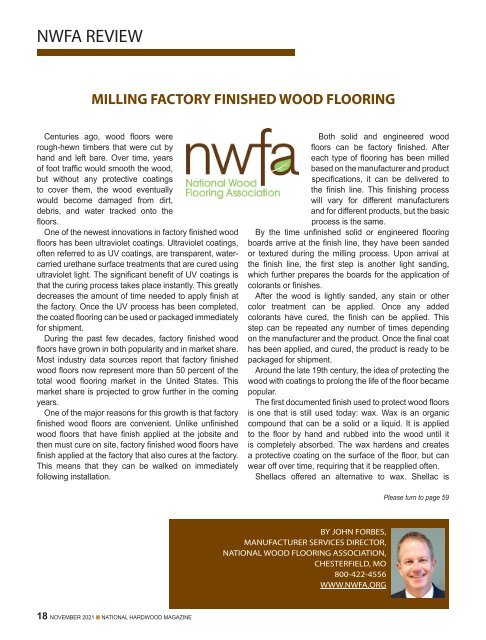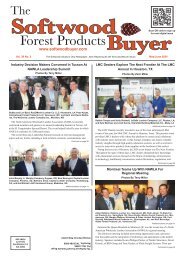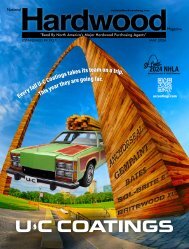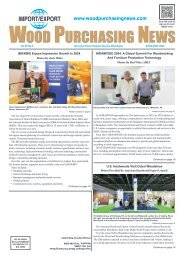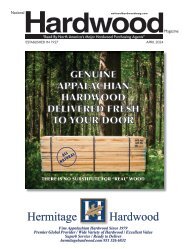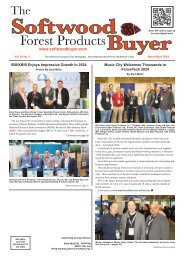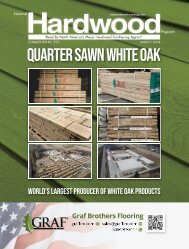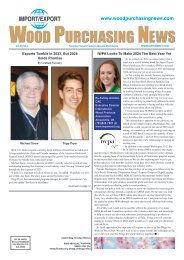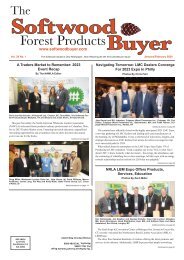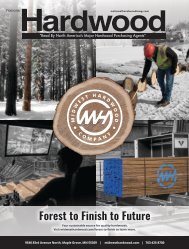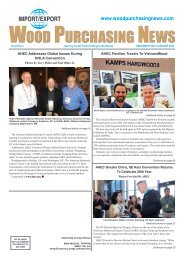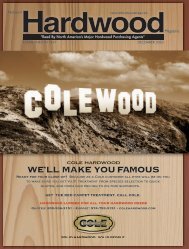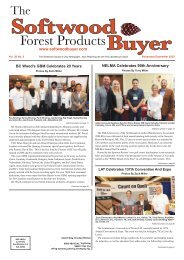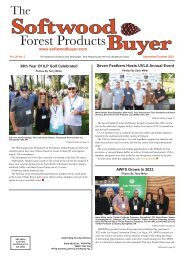National Hardwood Magazine - November 2021
In the November issue of National Hardwood Magazine, get the latest hardwood industry news, plus features on Tropical Forest Products, Dura Supreme Cabinetry, and the DMSi and eLIMBS merger.
In the November issue of National Hardwood Magazine, get the latest hardwood industry news, plus features on Tropical Forest Products, Dura Supreme Cabinetry, and the DMSi and eLIMBS merger.
You also want an ePaper? Increase the reach of your titles
YUMPU automatically turns print PDFs into web optimized ePapers that Google loves.
NWFA REVIEW<br />
MILLING FACTORY FINISHED WOOD FLOORING<br />
Centuries ago, wood floors were<br />
rough-hewn timbers that were cut by<br />
hand and left bare. Over time, years<br />
of foot traffic would smooth the wood,<br />
but without any protective coatings<br />
to cover them, the wood eventually<br />
would become damaged from dirt,<br />
debris, and water tracked onto the<br />
floors.<br />
One of the newest innovations in factory finished wood<br />
floors has been ultraviolet coatings. Ultraviolet coatings,<br />
often referred to as UV coatings, are transparent, watercarried<br />
urethane surface treatments that are cured using<br />
ultraviolet light. The significant benefit of UV coatings is<br />
that the curing process takes place instantly. This greatly<br />
decreases the amount of time needed to apply finish at<br />
the factory. Once the UV process has been completed,<br />
the coated flooring can be used or packaged immediately<br />
for shipment.<br />
During the past few decades, factory finished wood<br />
floors have grown in both popularity and in market share.<br />
Most industry data sources report that factory finished<br />
wood floors now represent more than 50 percent of the<br />
total wood flooring market in the United States. This<br />
market share is projected to grow further in the coming<br />
years.<br />
One of the major reasons for this growth is that factory<br />
finished wood floors are convenient. Unlike unfinished<br />
wood floors that have finish applied at the jobsite and<br />
then must cure on site, factory finished wood floors have<br />
finish applied at the factory that also cures at the factory.<br />
This means that they can be walked on immediately<br />
following installation.<br />
Both solid and engineered wood<br />
floors can be factory finished. After<br />
each type of flooring has been milled<br />
based on the manufacturer and product<br />
specifications, it can be delivered to<br />
the finish line. This finishing process<br />
will vary for different manufacturers<br />
and for different products, but the basic<br />
process is the same.<br />
By the time unfinished solid or engineered flooring<br />
boards arrive at the finish line, they have been sanded<br />
or textured during the milling process. Upon arrival at<br />
the finish line, the first step is another light sanding,<br />
which further prepares the boards for the application of<br />
colorants or finishes.<br />
After the wood is lightly sanded, any stain or other<br />
color treatment can be applied. Once any added<br />
colorants have cured, the finish can be applied. This<br />
step can be repeated any number of times depending<br />
on the manufacturer and the product. Once the final coat<br />
has been applied, and cured, the product is ready to be<br />
packaged for shipment.<br />
Around the late 19th century, the idea of protecting the<br />
wood with coatings to prolong the life of the floor became<br />
popular.<br />
The first documented finish used to protect wood floors<br />
is one that is still used today: wax. Wax is an organic<br />
compound that can be a solid or a liquid. It is applied<br />
to the floor by hand and rubbed into the wood until it<br />
is completely absorbed. The wax hardens and creates<br />
a protective coating on the surface of the floor, but can<br />
wear off over time, requiring that it be reapplied often.<br />
Shellacs offered an alternative to wax. Shellac is<br />
LET THE<br />
BAND MILL EXPERTS<br />
OF 130+ YEARS<br />
PROVIDE YOUR<br />
NEXT SET OF<br />
BAND MILL<br />
WHEELS<br />
Please turn to page 59<br />
BY JOHN FORBES,<br />
MANUFACTURER SERVICES DIRECTOR,<br />
NATIONAL WOOD FLOORING ASSOCIATION,<br />
CHESTERFIELD, MO<br />
800-422-4556<br />
WWW.NWFA.ORG<br />
info.mcdonough-mfg.com/wheels<br />
(715) 834-7755<br />
mcdonough@mcdonoughmfg.com<br />
18 NOVEMBER <strong>2021</strong> n NATIONAL HARDWOOD MAGAZINE


